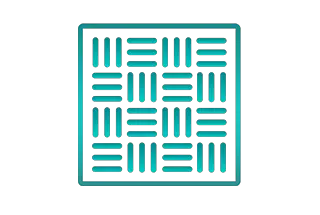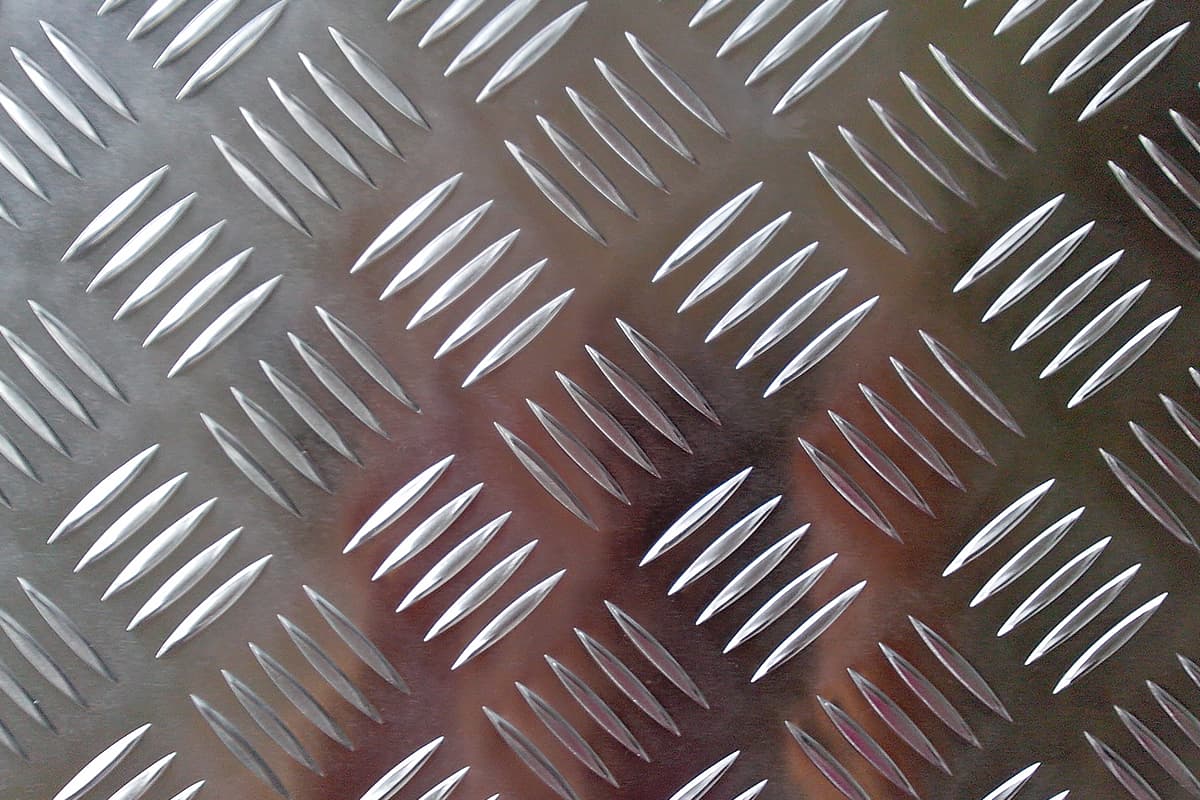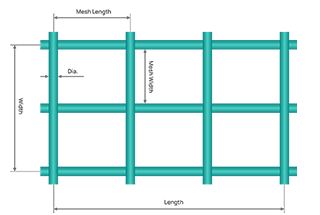
매일 보는 무늬가 있는 철판의 무게가 궁금한 적이 있나요? 이 블로그 포스팅에서는 체크무늬 강판의 매혹적인 세계에 대해 자세히 알아볼 것입니다. 다년간의 경험을 가진 기계 엔지니어로서 재료, 두께, 패턴 모양과 같은 요소가 이 다용도 강판의 무게에 어떤 영향을 미치는지에 대한 저의 인사이트를 공유해 드리겠습니다. 새롭고 흥미로운 것을 배울 준비를 하세요!

트레드 플레이트 또는 다이아몬드 플레이트라고도 하는 체크무늬 플레이트는 추가적인 접지력과 강도를 제공하는 돌출된 패턴이 있는 금속판입니다. 일반적으로 건설, 제조 및 운송 업계에서 바닥재, 계단 트레드 및 보호용 표면으로 사용됩니다.
체크무늬 강판의 무게는 재료 선택, 구조 설계 및 물류 계획에서 매우 중요한 요소입니다. 강판의 기본 재료 구성, 공칭 두께, 전체 치수, 돌출된 체크무늬의 특정 패턴 등 몇 가지 주요 파라미터에 따라 달라집니다.
표준 평강판의 무게를 계산할 때는 일반적으로 다음 공식을 사용합니다:
무게(kg) = 7.85 x 길이(m) x 너비(m) x 두께(m)
여기서 7.85는 연강의 밀도(g/cm³ 또는 kg/dm³)입니다. 그러나 체크무늬 플레이트의 경우 돌출된 패턴의 추가 재료를 고려하여 이 계산을 조정해야 합니다.
체크무늬 플레이트의 이론적 무게는 고유한 특성에 따라 달라집니다:
체크무늬 플레이트의 무게를 정확하게 추정하기 위해 제조업체는 무게 표 또는 보정 계수를 제공하는 경우가 많습니다. 일반적으로 패턴 사양에 따라 공칭 두께가 동일한 평판의 계산된 무게에 1.5 - 3%를 추가하는 것이 좋습니다.
체크무늬 플레이트의 평방미터당 이론적 무게는 특정 패턴 모양과 두께에 따라 크게 달라질 수 있습니다:
전반적으로 체크무늬 플레이트의 이론적 무게는 이러한 요인에 따라 최저 1.6kg/㎡에서 최대 29.5kg/㎡까지 다양합니다. 체크무늬 플레이트의 예상 무게를 결정할 때는 패턴 모양과 두께를 모두 고려하는 것이 중요합니다.

다이아몬드나 선과 같은 체크무늬 플레이트의 돌출된 패턴은 전체적인 부피와 무게를 증가시킵니다. 이러한 추가 무게는 일반적으로 미미하지만 정밀한 애플리케이션에서는 중요할 수 있습니다. 예를 들어, 체크무늬 패턴은 플레이트의 무게에 약 5-10%를 더 추가할 수 있습니다.
패턴을 고려하기 위해 계산에서 두께를 약간 조정할 수 있습니다:
조정된 두께 = 두께 + 패턴 높이
패턴 높이가 1mm인 경우 조정된 두께는 6mm(0.006미터)가 됩니다:
조정 중량=2m x 1m x0.006mx 7850kg/m3= 94.2kg
연강의 표준 밀도는 7850kg/m³이지만 실제 밀도는 특정 성분과 제조 공정에 따라 약간씩 다를 수 있습니다. 재료 공급업체가 제공한 정확한 밀도 값을 사용하면 가장 정확한 계산을 보장합니다.
온라인 계산기는 MS 체크무늬 접시의 무게를 빠르고 효율적으로 계산할 수 있는 방법을 제공합니다. 수작업으로 계산할 필요가 없고, 오류의 위험을 줄이며, 시간을 절약할 수 있습니다. 이러한 디지털 도구는 프로젝트에 정확한 측정이 필요한 건설, 제조, 운송 분야의 전문가에게 특히 유용합니다.
체크무늬 플레이트의 무게를 계산하는 것은 자재 취급, 비용 추정, 건설 및 제조의 구조적 무결성 보장 등 다양한 실제 애플리케이션에 필수적입니다.
체크무늬 플레이트의 무게를 측정하는 과정을 간소화하기 위해 특정 재료에 맞게 설계된 온라인 계산기를 사용할 수 있습니다. 이러한 계산기는 패턴 모양, 두께, 너비, 길이, 조각 수 등의 요소를 고려하여 예상 중량을 제공합니다.
체크무늬 연강(MS) 플레이트의 경우 다음 계산기를 사용하세요:
패턴 모양(다이아몬드, 렌틸콩, 둥근 콩)을 선택하고 두께(2.5mm ~ 8mm), 너비, 길이, 개수를 입력하면 계산기에 예상 중량이 킬로그램 단위로 표시됩니다.
관련 계산기:
체크무늬 알루미늄 판의 무게를 계산하려면 이 계산기를 사용하세요:
두께(2.5mm ~ 8mm), 너비, 길이, 개수를 입력하면 킬로그램 단위의 예상 중량을 얻을 수 있습니다.
중요 고려 사항:
이 계산기는 체크무늬 접시의 무게를 추정하는 편리한 방법을 제공하지만, 결과는 참고용으로만 제공된다는 점을 명심하세요. 플레이트의 실제 무게는 이론 무게와 0.2%에서 0.7%까지 오차 범위가 다를 수 있습니다.
거래 또는 기타 중요한 애플리케이션에 이러한 계산된 가중치를 사용할 때는 주의를 기울이고 정확성을 보장하기 위해 가능한 한 실제 가중치를 확인하시기 바랍니다.
빠른 참조를 위해 다양한 두께와 패턴 형태의 체크무늬 강판에 대한 종합적인 중량 차트를 참조하세요.
| 두께 (mm) | 허용 편차 (mm) | 다이아몬드 (kg/m²) | 렌틸콩 (kg/m²) | 둥근 콩 (kg/m²) |
|---|---|---|---|---|
| 2.5 | ±0.3 | 21.6 | 21.3 | 21.1 |
| 3 | ±0.3 | 25.6 | 24.4 | 24.3 |
| 3.5 | ±0.3 | 29.5 | 28.4 | 28.3 |
| 4 | ±0.4 | 33.4 | 32.4 | 32.3 |
| 4.5 | ±0.4 | 38.6 | 38.3 | 36.2 |
| 5 | 0.4 | 42.3 | 40.5 | 40.2 |
| 5 | -0.5 | 42.3 | 40.5 | 40.2 |
| 5.5 | 0.4 | 46.2 | 44.3 | 44.1 |
| 5.5 | -0.5 | 46.2 | 44.3 | 44.1 |
| 6 | 0.5 | 50.1 | 48.4 | 48.1 |
| 6 | -0.6 | 50.1 | 48.4 | 48.1 |
| 7 | 0.6 | 59 | 58 | 52.4 |
| 7 | -0.7 | 59 | 58 | 52.4 |
| 8 | 0.6 | 66.8 | 65.8 | 56.2 |
| 8 | -0.8 | 66.8 | 65.8 | 56.2 |
| 두께 (mm) | 무게 (kg/m²) |
| 2.5 | 22.6 |
| 3 | 26.6 |
| 3.5 | 30.5 |
| 4 | 34.4 |
| 4.5 | 38.3 |
| 5 | 42.3 |
| 6 | 50.1 |
| 8 | 66.8 |
중요 참고 사항:
체크무늬 강판으로 작업할 때는 이 중량 차트를 유용한 가이드로 활용하세요. 허용 편차를 고려하고 특정 용도에 필요한 경우 강재 등급 및 기계적 특성에 대한 적절한 표준을 참조하는 것을 잊지 마세요.
체크무늬 강판의 무게(kg/㎡)는 강판 두께와 특정 패턴 모양에 따라 달라집니다. 다음은 일반적인 두께와 패턴의 무게에 대한 분석입니다:
2.5mm 두께
3mm 두께
3.5mm 두께
4mm 두께
4.5mm 두께
5mm 두께
5.5mm 두께
6mm 두께
7mm 두께
8mm 두께
이 정보를 사용하여 필요한 두께와 선호하는 패턴 모양에 따라 체크무늬 강판의 예상 중량을 빠르게 결정할 수 있습니다. 이 데이터는 프로젝트에 사용할 자재를 선택하고 운송 및 설치 목적의 총 중량을 예측할 때 정보에 입각한 결정을 내리는 데 도움이 될 수 있습니다.
체크무늬 접시의 정확한 무게 계산을 위해서는 몇 가지 주요 고려 사항에 세심한 주의를 기울여야 합니다. 이러한 단계를 통해 접시의 무게에 영향을 미치는 모든 요소를 고려하여 정확하고 신뢰할 수 있는 결과를 도출할 수 있습니다.
캘리퍼스, 마이크로미터, 저울과 같은 측정 기기는 정기적으로 교정하는 것이 필수적입니다. 이를 통해 길이, 너비, 두께, 무게의 측정값을 정확하게 유지하여 최종 계산에서 발생할 수 있는 오류의 위험을 최소화할 수 있습니다.
계산 오류를 방지하려면 모든 측정에 일관된 단위를 유지하는 것이 중요합니다. 길이, 너비, 유효 두께는 동일한 단위(일반적으로 부피 계산의 경우 미터(m)로 측정)로 측정해야 합니다. 모든 두께 측정값은 밀리미터(mm)에서 1000으로 나누어 미터(m)로 변환해야 합니다.
체크무늬 플레이트의 치수를 정확하게 측정하는 것이 중요합니다:
체크무늬 플레이트의 돌출된 패턴은 전체 두께와 부피에 영향을 미칩니다. 패턴 커버리지(PC)를 정확하게 결정하고 이를 유효 두께 계산에 반영하는 것은 필수적입니다. 패턴 커버리지를 잘못 추정하면 무게 계산이 잘못될 수 있습니다. 공식을 사용하세요:
여기서 ( Tbase )는 기본 두께, ( H패턴 )는 돌출된 패턴의 높이이고, ( PC )는 10진수로 표시된 패턴 범위입니다.
예시: 기본 두께가 5mm, 패턴 높이가 1mm, 패턴 커버리지가 20%(0.20)인 체크무늬 판을 예로 들어 보겠습니다. 유효 두께는 다음과 같습니다:
정확한 재료 밀도를 사용하는 것이 중요합니다. 재료마다 밀도가 다르기 때문에 잘못된 밀도를 사용하면 무게 계산이 부정확해질 수 있습니다. 일반적인 밀도는 다음과 같습니다:
정확성을 보장하기 위해 신뢰할 수 있는 출처에서 자료 밀도를 확인합니다.
환경 조건은 측정에 영향을 미칠 수 있습니다. 예를 들어, 온도 변화로 인해 재료가 팽창하거나 수축하여 길이 및 두께 측정의 정확도에 영향을 미칠 수 있습니다. 이러한 영향을 최소화하려면 통제된 환경에서 측정을 수행하세요.
여러 번 측정하고 평균을 내면 정확도를 높일 수 있습니다. 여러 지점에서 길이, 너비, 두께를 측정하고 평균값을 계산에 사용합니다. 이 접근 방식은 플레이트 치수의 불규칙성이나 변화를 설명하는 데 도움이 됩니다.
계산을 수행한 후에는 알려진 표준과 비교하거나 다른 방법을 사용하여 결과를 확인합니다. 온라인 체크무늬 접시 무게 계산기로 교차 확인하면 정확성을 추가로 확인할 수 있습니다.
이러한 특정 고려 사항을 해결하면 체크무늬 플레이트의 무게를 정확하게 계산하여 다양한 실제 응용 분야에서 신뢰성과 정밀도를 보장할 수 있습니다.
체크무늬 플레이트의 중량을 정확하게 계산하는 것은 실제 적용, 비용 고려 사항, 업계 표준 준수 등 여러 가지 이유로 매우 중요합니다. 중량 계산의 중요성을 이해하면 자재 사용을 최적화하고 구조적 무결성을 보장하며 물류를 효과적으로 관리하는 데 도움이 됩니다.
건설 및 엔지니어링 프로젝트에서 구조물의 무결성과 안전을 유지하려면 체크무늬 후판의 정확한 무게를 아는 것이 필수적입니다. 구조물에 과부하가 걸리면 치명적인 고장이 발생할 수 있고, 반대로 과소하중은 자재의 비효율적인 사용으로 이어질 수 있습니다. 예를 들어, 보행자 전용 교량을 건설할 때 정확한 무게 계산을 통해 지지 구조물이 하중을 견딜 수 있는지 확인하면 사고를 예방하고 안전성을 높일 수 있습니다. 2018년 뉴욕의 한 교량 프로젝트 사례 연구에 따르면 정확한 무게 계산으로 구조물 고장 위험이 30% 감소한 것으로 나타나 정밀한 측정의 중요성을 강조했습니다.
정확한 무게 계산은 다양한 방식으로 비용 효율성에 직접적인 영향을 미칩니다:
무게 계산은 제품 및 구조물의 설계와 엔지니어링에서 기본이 됩니다. 엔지니어와 설계자는 무게 데이터를 사용하여 다음과 같은 작업을 수행합니다:
효과적인 재고 관리는 정확한 중량 계산에 달려 있습니다. 체크무늬 접시의 무게를 알면 도움이 됩니다:
정확한 무게 계산은 환경 지속 가능성에 기여합니다:
체크무늬 플레이트의 무게 계산은 다양한 산업 분야에서 실용적으로 활용되고 있습니다:
정확한 중량 계산은 엔지니어링, 디자인, 물류 및 환경 관리의 여러 측면에 걸쳐 필수적인 요소입니다. 정확한 중량 계산을 이해하고 적용함으로써 업계는 더 나은 안전 표준, 비용 효율성 및 지속 가능한 관행을 달성할 수 있습니다.
건설에서 제조에 이르기까지 다양한 산업에서 체크무늬 플레이트의 무게를 정확하게 계산하는 것은 매우 중요합니다. 무게를 이해하면 자재 취급, 비용 추정 및 구조 설계에 도움이 됩니다. 이 장에서는 중량 계산 프로세스와 관련된 필수 매개변수를 자세히 살펴보고 정확한 측정을 위한 포괄적인 가이드를 제공합니다.
다음은 자주 묻는 질문에 대한 답변입니다:
체크무늬 접시의 치수를 정확하게 측정하려면 다음 단계와 고려 사항을 따르세요:
두께를 측정할 때는 융기된 체커 패턴이 아닌 시트의 평평한 영역에서 측정해야 합니다. 돌출된 패턴은 오해의 소지가 있을 정도로 더 높은 두께를 측정할 수 있습니다. 예를 들어 2.5mm 두께의 체크무늬 판의 경우 평평한 영역에서 측정하면 2.35mm~2.5mm로 측정되지만 돌출된 프로파일에서 측정하면 최대 3.61mm까지 잘못 측정될 수 있습니다.
체크무늬 접시의 길이와 너비를 측정하려면 줄자나 자를 사용합니다. 플레이트의 길이와 너비를 밀리미터 또는 원하는 측정 단위로 측정합니다. 이 측정은 플레이트의 평평한 부분을 정확하게 측정해야 합니다.
정확도를 높이려면 평평한 부분과 돌출된 부분 모두에서 플레이트의 여러 부분을 여러 번 측정하되, 기본 측정값은 평평한 부분에서 측정해야 합니다. 이렇게 하면 두께나 기타 치수의 변화를 설명하는 데 도움이 됩니다.
캘리퍼스나 자 같은 적절한 측정 도구를 사용하세요. 두께를 측정할 때는 디지털 캘리퍼스를 사용하면 더 정확한 측정값을 얻을 수 있습니다.
다음은 측정 과정의 예시입니다:
다음 단계를 따르면 체크무늬 플레이트의 치수를 정확하고 안정적으로 측정할 수 있습니다.
체커 플레이트 또는 다이아몬드 플레이트라고도 하는 체크무늬 플레이트는 일반적으로 강철 또는 알루미늄으로 만들어지며, 각각 다양한 용도에 적합한 고유한 특성을 제공합니다. 열간 압연되는 연강 체크무늬 플레이트는 내구성이 뛰어나 고강도 용도에 널리 사용되며 A36, SS400, SPCC, SPHC, Q195, Q235 및 Q345와 같은 등급으로 제공됩니다. 아연 도금 강판은 아연 코팅으로 부식 및 녹 방지 기능을 강화하여 외부 환경에 대한 저항력이 중요한 환경에 적합합니다. 스테인리스 스틸 체크무늬 강판은 내식성과 내열성이 뛰어나 식품 가공, 화학 및 제약 분야와 같이 높은 위생 및 위생 기준이 요구되는 산업에서 선호됩니다.
알루미늄 체크무늬 판재는 가볍고 부식에 강한 특성으로 인해 항공우주 및 운송과 같이 무게를 줄여야 하는 분야에 이상적입니다. 일반적으로 사용되는 알루미늄 합금으로는 내식성과 가공성이 뛰어난 1100, 강도가 높아 식품 및 화학 장비에 사용되는 3003, 강도와 용접성이 뛰어나 해양 선박 및 컨테이너에 사용되는 5083, 내식성과 고강도가 뛰어나 덤프 바디 및 해양 부품에 사용되는 5454가 있습니다.
스틸 및 알루미늄 체크무늬 플레이트는 1바, 3바, 5바 다이아몬드 패턴 등 다양한 패턴으로 제공되어 미끄럼 방지 특성을 강화합니다. 이러한 플레이트는 표면을 보호하고 내구성을 높이기 위해 아연 도금 또는 파우더 코팅으로 마감할 수도 있습니다.
체크무늬 접시의 패턴은 무게에 최소한의 영향을 미칩니다. 체크무늬 플레이트의 무게는 주로 다음 공식을 사용하여 재료의 부피와 밀도에 따라 결정됩니다: 무게 = (길이 × 너비 × 두께) × 밀도. 이 공식은 패턴을 직접 고려하지 않고 전체 치수와 재료의 밀도를 기준으로 무게를 계산합니다.
체크무늬 접시에 선이나 다이아몬드와 같은 돌출된 패턴을 넣으면 접시에 약간의 부피가 추가됩니다. 그러나 이 추가 부피는 일반적으로 무시할 수 있는 수준이며 무게에 큰 영향을 미치지 않습니다. 돌출된 패턴을 제외한 플레이트의 기본 두께가 무게 계산의 주요 요소로 남아 있습니다.
재료의 밀도는 패턴에 관계없이 일정하게 유지되므로 무게 계산은 이러한 사소한 부피 변화의 영향을 거의 받지 않습니다. 실제 애플리케이션에서 체크무늬 플레이트의 무게는 일반적으로 그 차이가 너무 작아 크게 중요하지 않기 때문에 융기된 패턴을 조정하지 않고 계산됩니다. 공급업체와 업계 표준은 일반적으로 기본 재료의 밀도와 플레이트의 전체 치수를 기준으로 무게 추정치를 제공하며 패턴의 사소한 기여도는 무시합니다.
결론적으로, 체크무늬 플레이트의 패턴은 부피에 약간의 변화를 가져올 수 있지만, 이러한 변화는 무게 계산에 의미 있는 영향을 미칠 만큼 중요하지 않습니다. 무게는 주로 플레이트의 크기와 재료의 밀도에 의해 결정됩니다.
예, 위의 무료 온라인 계산기를 통해 체크무늬 접시의 무게를 추정할 수 있습니다. 이 도구를 사용하면 특정 치수와 재료 특성을 입력하여 정확한 무게를 계산할 수 있습니다. 다음은 몇 가지 주목할 만한 옵션입니다:
온라인 계산기는 자재 선택, 구조 설계 및 물류 계획에 필수적인 체크무늬 플레이트의 무게를 추정하는 데 편리하고 정확한 도구입니다.








